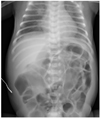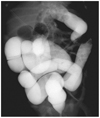Abstract
A 28-year-old primigravida woman had marked polyhydramnios and multiple dilated bowel loops were seen in the fetal abdomen on prenatal ultrasound, we suspected the ileal atresia. After birth by preterm premature rupture of the membrane at 33 weeks, imaging studies showed dilated bowels without evidence of intestinal obstruction or intestinal atresia. The neonate had watery diarrhea like urine and measurement of ionic content of the stool led to the diagnosis of congenital chloride diarrhea (CCD). The neonate was placed on sodium and potassium chloride supplements, and his condition was improved. CCD is a rare, inherited condition caused by an abnormality of intestinal electrolyte transport. This case illustrates that it may present prenatally with a picture similar to that seen with intestinal obstruction including ileal atresia.
Figures and Tables
References
1. Poggiani C, Auriemma A, Menghini P, Lando B, Bonhoeffer P, Colombo A. Darrow-Gamble disease: ultrasonographic and radiographic findings. Pediatr Radiol. 1993. 23:65–66.
2. Wedenoja S, Pekansaari E, Höglund P, Mäkelä S, Holmberg C, Kere J. Update on SLC26A3 mutations in congenital chloride diarrhea. Hum Mutat. 2011. 32:715–722.
3. Hihnala S, Höglund P, Lammi L, Kokkonen J, Ormälä T, Holmberg C. Long-term clinical outcome in patients with congenital chloride diarrhea. J Pediatr Gastroenterol Nutr. 2006. 42:369–375.
4. Langer JC, Winthrop AL, Burrows RF, Issenman RM, Caco CC. False diagnosis of intestinal obstruction in a fetus with congenital chloride diarrhea. J Pediatr Surg. 1991. 26:1282–1284.
5. Rose NC, Kaplan P, Scott S, Kousoulis A, Librizzi R. Prenatal presentation of congenital chloride diarrhea: clinical report and review of the literature. Am J Perinatol. 1992. 9:398–400.
6. Eğrıtaş O, Dalgiç B, Wedenoja S. Congenital chloride diarrhea misdiagnosed as Bartter syndrome. Turk J Gastroenterol. 2011. 22:321–323.
7. Abdullah AM, Shaheed MM, Katugampola SM, Patel PJ. Congenital chloride diarrhoea: case report and review of the literature. Ann Trop Paediatr. 1990. 10:71–74.
8. Lundkvist K, Ewald U, Lindgren PG. Congenital chloride diarrhoea: a prenatal differential diagnosis of small bowel atresia. Acta Paediatr. 1996. 85:295–298.
9. Hartikainen-Sorri AL, Tuimala R, Koivisto M. Congenital chloride diarrhea: possibility for prenatal diagnosis. Acta Paediatr Scand. 1980. 69:807–808.
10. Holmberg C. Congenital chloride diarrhoea. Clin Gastroenterol. 1986. 15:583–602.
11. Kagalwalla AF. Congenital chloride diarrhea. A study in Arab children. J Clin Gastroenterol. 1994. 19:36–40.
12. Lok KH, Hung HG, Li KK, Li KF, Szeto ML. Congenital chloride diarrhea: a missed diagnosis in an adult patient. Am J Gastroenterol. 2007. 102:1328–1329.
13. Lechner S, Ruemmele FM, Zankl A, Lausch E, Huber WD, Mihatsch W, et al. Significance of molecular testing for congenital chloride diarrhea. J Pediatr Gastroenterol Nutr. 2011. 53:48–54.
14. Mayatepek E, Seyberth HW, Nützenadel W. Effects of indomethacin in congenital chloride diarrhea. J Pediatr Gastroenterol Nutr. 1992. 14:319–322.
15. Pieroni KP, Bass D. Proton pump inhibitor treatment for congenital chloride diarrhea. Dig Dis Sci. 2011. 56:673–676.




 PDF
PDF ePub
ePub Citation
Citation Print
Print






 XML Download
XML Download